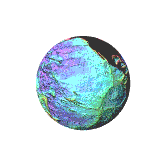Is The Sea Really On The Level?
 When we measure the height of mountains, we measure from a constant number called sea level. For instance Mount Whitney in California is 14,494 feet (4,418 m) above sea level. We start at 0 feet and end up precisely, by careful measurement, at 14,494 feet (4,418 m) . That sounds well and good until you consider that sea level IS NOT a constant. It is a variable.
When we measure the height of mountains, we measure from a constant number called sea level. For instance Mount Whitney in California is 14,494 feet (4,418 m) above sea level. We start at 0 feet and end up precisely, by careful measurement, at 14,494 feet (4,418 m) . That sounds well and good until you consider that sea level IS NOT a constant. It is a variable.
Different scientists use difference reference points for sea level. An oceanographer might use a still water level, a measurement made up of the average of high tides. While a geologist might use a measurement equal to the surface of an unmoving global ocean, called the geoid. So right from the start, sea level means different things to different people. At least within their own discipline, scientists seem to be talking about the same sea level.
But not so fast. Earth’s gravity itself is variable. Large mass congregated in one spot actually increases, albeit slightly, the gravitational tug of the Earth. Now picture an underwater mountain, called a seamount. Because of its gravitational attraction, it actually pulls water towards it and creates a dome effect on the ocean’s surface. The sea level at the peak of this dome can actually be as much as 165 feet (about 50 m) over the geoid. The opposite is true of the water’s surface over the Mariana trench in the Pacific Ocean. There, sea level dips mirroring the contours of the under sea topography. So next time someone talks about sea levels rising, ask them which sea level they are talking about.
About the Author
Gene Mascoli, JD
 Gene Mascoli is a founder and publisher of ScienceIQ.com. He holds a J.D. degree from the University of Santa Clara and a B.A. in English. In 1997 Gene launched ScienceMaster.com, an online science education portal where he brought together his love of writing with his interest in the sciences. Gene collaborated with David Gamon on the popular digital book
“The Internet Guide to NASA on the Net” and has also produced two popular science CD-ROMs on astronomy and space science.
Gene Mascoli is a founder and publisher of ScienceIQ.com. He holds a J.D. degree from the University of Santa Clara and a B.A. in English. In 1997 Gene launched ScienceMaster.com, an online science education portal where he brought together his love of writing with his interest in the sciences. Gene collaborated with David Gamon on the popular digital book
“The Internet Guide to NASA on the Net” and has also produced two popular science CD-ROMs on astronomy and space science.


